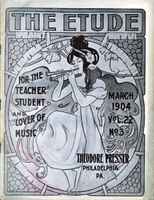A writer for The Strad, who is obviously impressed with the narrow views and the one-sided training of a deplorable number of our players, has a few common-sense things to say which we consider worthy of repetition. Says he:—
"I readily admit that harmonics are not the most beautiful things in violin playing, for they certainly belong to the sensational but usually effective side. However, in my opinion you ought to have an ambition to ascend to the summit of a mountain, as well as to dwell in a lovely valley. It is just as good for you in its own particular way. In order to avoid sensationalism, you must not go into bigotry. I like a violinist who can do and appreciate all things on the violin. With all due respect to the pupils of the Spohr school of playing—for which they naturally have an enthusiastic admiration—I would not ignore solos and concertos containing passages of harmonics, in these days of so much virtuosity. If the former ignore the latter, they are liable to become one-sided. Classical and beautiful playing as these followers show, they are oftener under the influence of public opinion than of their real natures. They are opposed to sensationalism because they want to be thought classical exponents.
"If you wish to be a soloist of every distinction, I think you ought to make special study of harmonics. But in doing so, remember the word 'moderation.' Although extremely brilliant, they are apt to become a little monotonous. For, after all, harmonics can only astonish your listeners. They can never satisfy or convince them of your ardent feeling, or of the calmness and solidity of your playing.
"You want a little audacity, a dare-devil sort of feeling, to play harmonics well. No hesitation; use very little bow; each stroke to be smart and short, exceedingly so in both cases, with scarcely any weight on the string. The best works in harmonics that I know of are:—
" 'Paganini Kunst,' by Guber, published by Schott.
" 'Hofmann's Technic,' last book, published by Zimmermann.
" 'Paganini Compositions,' published by Schott.
"You will often hear people accusing you of trickery, particularly those that cannot do harmonics. They will try to give you advice. But their ideas in this direction are such, and so numerous, they can only be viewed as a humiliating monument of human perverseness. The interest which harmonics excite, and the favor they obtain in the present day, cannot be denied. It is something of a novelty to hear clear harmonic playing. It might be added, everyone is fond of what has the appearance of novelty.
"But there is such a thing as proportion—as equilibrium—which should always be most carefully maintained by a soloist if he would promote his own welfare. It may seem puerile to insist upon such an obvious fact. The success of a soloist depends on the preservation of an equilibrium between its various elements. All violinists, with very rare exceptions, in their different spheres, in their way, and according to their ability, either belong to the school of which Corelli and Tartini are the head, or to the Paganini school. But don't rail against Paganini because you prefer Tartini and Spohr, or vice versa. Whichever you belong to is abundant proof that you are on the right track. But why not combine the two? If you take the works of both schools, and study them, you will find both exemplary. I conceive that your powers and faculties, your energies and conceptions, and the activeness of your imagination should be divided between the two. The violin has a wide range, in which you have beauty of tone and brilliance of technic. You can surely direct your attention to works by Paganini, Vieuxtemps, and Wieniawski, as well as to Bach, Spohr, and Brahms. You can surely appreciate the playing of Sarasate as well as that of Joachim; you can enjoy staccato, arpeggio, and feather bowing as well as cantabile playing; and you certainly ought to practice harmonics and left-hand pizzicato, as well as double- stopping and chords. Thus you have a variety of things, all related to each other, and forming, when you get them all to a state of efficiency, a violinist complete."



